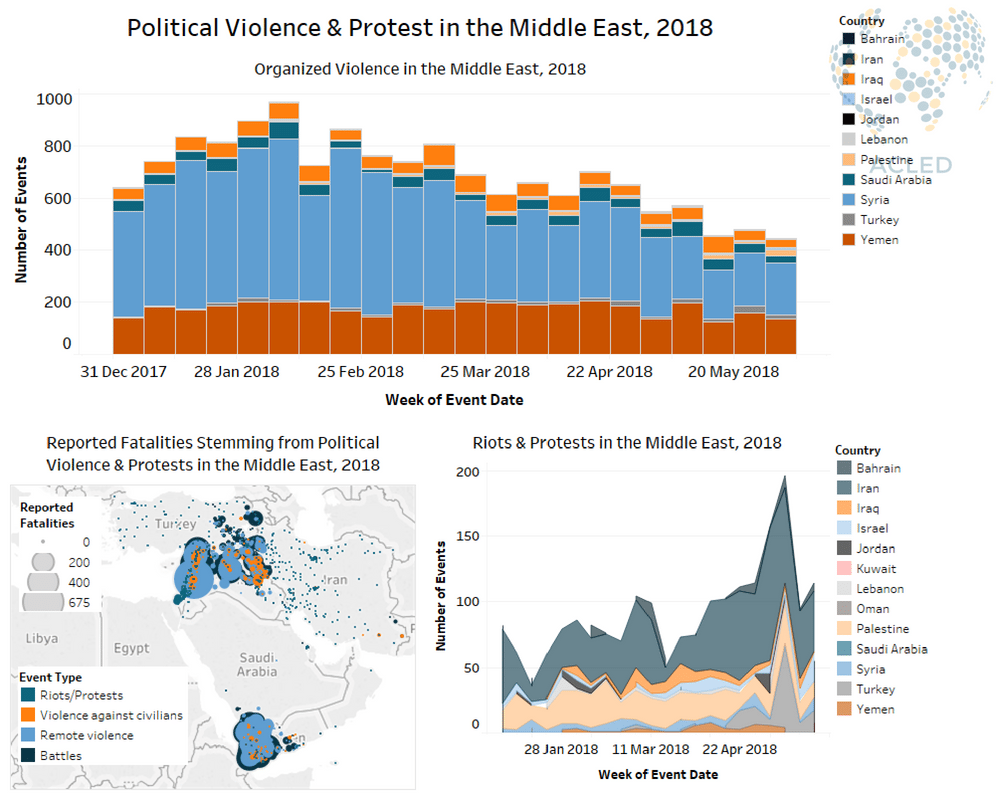This past week was marked by major protests in Jordan and a rise in remote violence between Israel and Gaza. A drop in political violence has been recorded in Iraq following the arrest of senior Islamic State (IS) figures over the past few weeks. Meanwhile, in Yemen intense clashes were reported on the front-lines, while in Aden conflict broke out between UAE-backed forces and Southern Resistance partisans.
Massive demonstrations were reported this past week in Jordan against a recent tax increase and the proposed introduction of an income tax as part of the government’s ongoing austerity policy (CNN, June, 4, 2018). These events mark an escalation in demonstrations against the IMF-backed austerity measures in the country. Although they have been largely peaceful in the past, last week’s demonstrations included violent riots in several areas involving demonstrators clashing with police, who in turn fired tear gas and blocked roads to disperse the demonstrations. The state appears to be taking the demonstrations seriously, acceding to one of the demonstrators’ demands and dismissing Prime Minister Hani al-Malichi in favour of education minister Omar al-Razzaz (BBC, June 6, 2018).
Meanwhile, a rise in the number of remote violence events on both sides of the Israel-Gaza border was recorded last week. These attacks began after an Israeli tank reportedly killed three members of the Palestinian Islamic Jihad (PIJ) who had been attempting to plant explosives near the border (Haartez, May 27, 2018). Following this clash, PIJ began firing mortars into Israel, most of which were stopped by Israeli Iron Dome defenses. Israel retaliated with airstrikes against more than 65 targets in Gaza (Times of Israel, May 31, 2018).
In Iraq, the number of political violence events continues to fall as another senior IS leader was arrested. Last week, the Islamic State’s “chief of explosives” was arrested in Diyala along with several other militants. This follows the arrest of five senior commanders in May, including the commanders of the “Euphrates Wilayat” and “Al-Mayadin” areas (as defined by IS), and the commander of their “strike force” in Ninewa province.
In Syria, state forces and allied militias carried out shelling in areas of northern Hama held by opposition groups, while their forces continued mobilizing southward in Dar’a and Quneitra governorates. The government has been targeting key locations in these southern governorates, seemingly in preparation for an impending offensive should southern opposition factions reject the proposed “reconciliation and evacuation” deals. Several protests also took place across Dar’a governorate, where demonstrators called on opposition groups to reject agreement with the Syrian government. Southern opposition groups began their own mobilization efforts in anticipation of a government offensive, with several rebel groups joining forces under a new alliance: Jaysh al-Inqaz, or “Rescue Army”.
In northeast Syria, state and allied forces continue to clash with IS fighters in Deir-ez-Zor governorate and across the Homs desert, where neither side has been able to advance. Meanwhile, Syrian Democratic Forces achieved limited advances against IS in eastern Deir-ez-Zor as Global Coalition airstrikes hit IS-held areas in both Deir-ez-Zor and Al-Hasakeh governorate.
Elsewhere in the country, suspected Israeli warplanes carried out airstrikes against a Hezbollah position in Damascus city (see “Israeli Strikes on Syria” for more on this). In Idleb province, the campaign of assassinations of Tahrir al-Sham (HTS) fighters by unidentified forces continued, with HTS forces imposing security measures in several cities and areas as they sought those responsible for the killings.
In Yemen, intense battles were reported last week between Houthi troops and Saudi coalition-backed forces, including National Resistance militias, the southern “Giants” brigades, and Tihama Resistance militias. These clashes took place in Durayhimi district of Hodeidah with some clashes reported only 6 kilometers away from the strategic Hodeidah international airport. UAE-backed forces also took control of the Zaraniq military camp just south of Hodeidah, and additional advances were made by National resistance forces into At Tuhayta district. Prime Minister Ahmed bin Daghr, head of the internationally recognized government, has claimed that most of Hodeidah has now been captured by anti-Houthi forces, and that Taizz, Ibb, Al-Mahwit, and Sadah provinces will likewise be retaken soon (Anadolu Agency, May 30, 2018).
Elsewhere in the country, clashes took place on May 27 in Aden city’s Martyr’s Square as UAE-backed Security Belt forces moved in to disperse demonstrators demanding the release of Southern Resistance leader Walid al Idrisi (Yemen Extra, May 27, 2018). Al Idrisi was arrested earlier that day by UAE-backed forces, allegedly due to the appearance of anti-UAE graffiti in the city, and taken to a UAE-controlled facility.






